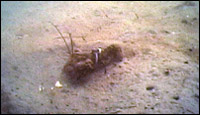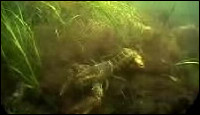Tracking Lobsters in the Mesocosm
 Figure 1 |
|
 Figure 2 |
|
 Figure 3 |
|
 Video 1 (Click to play) |
|
 Video 2 (Click to play) |
There are two basic habitat types in the mesocosm: eelgrass and sand/sediment. At Right are views of a lobster in each habitat type.
The lobster in Figure 2 is equipped with an ultrasonic transmitter and it was residing in a pit in the sand. Below the pictures are videos of the same lobsters.
Fitting a Lobster with a TransmitterLobsters in the mesocosm are tracked with VEMCO ultrasonic transmitters. These are designed to last for 3 months. We glue the transmitters inside a short piece of PVC tubing, through which we pass a cable-tie. Lobsters are captured underwater and, after collecting data concerning their sex, site, molt-stage, etc., they are fitted with the transmitters. The picture on the left, below, shows a diver attaching the transmitter and the picture on the right shows the lobster fitted with the transmitter.
Tracking Lobsters
We use the VEMCO VRAP telemetry system to track up to 5 lobsters, and one reference pinger, at a time. Three buoys are moored in a triangle around the mesocosm. Hydrophones in each buoy detect pulses from one of the transmitters, and then relay this information, via radio-transmission, to a receiver on shore. The base-station is connected to a computer and the VRAP software calculates the position of the lobsters based on time of arrival of the pulses at each of the buoys. The system is capable of simultaneously tracking up to 6 different transmitters, each of which is operating at a different frequency. Typically, we obtain a fix for each lobster every 2 minutes. When buoy movement and other factors are taken into account, the system appears to have an accuracy of approximately 1 meter.
